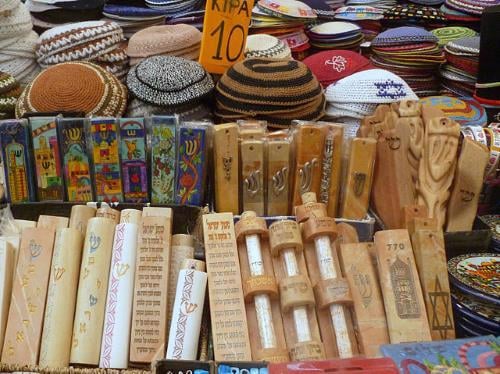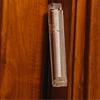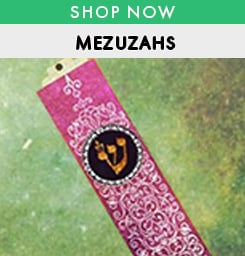In this article:
The Scroll
As per Biblical commandment, two portions of Deuteronomy are written on the Mezuzah parchment scroll in their original Hebrew. The verses, from 6:4-9 and 11:13-21, are:
Hear, O Israel, the L‑rd is our G‑d, the L‑rd is One.
You shall love the L‑rd your G‑d with all your heart, with all your soul, and with all your might. And these words which I command you today shall be upon your heart. You shall teach them thoroughly to your children, and you shall speak of them when you sit in your house and when you walk on the road, when you lie down and when you rise. You shall bind them as a sign upon your hand, and they shall be for a reminder between your eyes. And you shall write them upon the doorposts of your house and upon your gates.
And it will be, if you will diligently obey My commandments which I enjoin upon you this day, to love the L‑rd Your G‑d and to serve Him with all your heart and with all your soul, I will give rain for your land at the proper time, the early rain and the late rain, and you will gather in your grain, your wine and your oil. And I will give grass in your fields for your cattle, and you will eat and be sated. Take care lest your heart be lured away, and you turn astray and worship alien gods and bow down to them. For then the L‑rd's wrath will flare up against you, and He will close the heavens so that there will be no rain and the earth will not yield its produce, and you will swiftly perish from the good land which the L‑rd gives you. Therefore, place these words of Mine upon your heart and upon your soul, and bind them for a sign on your hand, and they shall be a reminder between your eyes. You shall teach them to your children, to speak of them when you sit in your house and when you walk on the road, when you lie down and when you rise. And you shall inscribe them on the doorposts of your house and on your gates-so that your days and the days of your children may be prolonged on the land which the L‑rd swore to your fathers to give to them for as long as the heavens are above the earth.
These verses are the only inscription on the parchment scroll (except for one of G‑d’s names, Sha-dai, which is inscribed on the reverse side) and emphasize our belief in the oneness of G‑d.

The Scribe

The Mezuzah scroll is made from handmade parchment from a kosher animal and inscribed in black ink with a special quill pen. It is written by a specially trained, religious devout scribe, known in Hebrew as a sofer. The sofer concentrates intensely and writes with special Hebrew characters in a beautiful calligraphic hand.
A Mezuzah has 713 letters. Every letter has numerous laws pertaining to its form. In order for a Mezuzah to be written in accordance with all of the laws, it must meet thousands of requirements.
If even one of the Mezuzah’s 713 letters is missing, or shaped incorrectly, the Mezuzah is rendered invalid and the commandment is unfulfilled. Even the best scribe is human and subject to error. While some errors can be corrected in accordance with Jewish law, others cannot. Therefore, when a Mezuzah is purchased from a reputable seller, it is inspected by a second scribe before being sold.
What to Look for When Buying a Mezuzah
Choose a source: The first thing to do is locate where you want to purchase your mezuzah. As there are many nuances that are not visible to the untrained eye, as well as some that are impossible to detect, it is imperative to purchase your mezuzah from a trusted, G‑d-fearing source.
Choose a type: There are several traditions regarding how the letters should be formed. It is ideal to use a mezuzah that follows the customs of your community. Larger scrolls are often more expensive but allow for a cleaner, clearer, and more detailed script. It is worth going the extra mile.
Ask to look: It’s OK to ask the merchant to show you the mezuzah you intend to purchase. When inspecting a mezuzah scroll, one can immediately tell the difference between a high-quality well-crafted script and a hastily written text, which may be kosher but is certainly not ideal.
For more on the making of the mezuzah scroll, see The Scribal Art. Get a mezuzah scroll from our online store.

The Mezuzah Case
 The Mezuzah should be placed inside a protective case. The scroll should be rolled from left to right, so that G‑d’s name, “Sha-dai,” is facing the front. It is then placed right-side-up inside the case, with the Sha-dai in front. If you do not have a Mezuzah case, wrap the Mezuzah in thick paper or some other material.
The Mezuzah should be placed inside a protective case. The scroll should be rolled from left to right, so that G‑d’s name, “Sha-dai,” is facing the front. It is then placed right-side-up inside the case, with the Sha-dai in front. If you do not have a Mezuzah case, wrap the Mezuzah in thick paper or some other material.
Mezuzahs are often acquired from the sofer or Judaica store already rolled and encased. It is important to make sure you obtain your Mezuzahs from a reliable source, so that you can be sure they have been placed properly. Sometimes, Mezuzah cases are sold fraudulently, with a photocopied paper scroll which does not fulfill the commandment, or even completely empty!
There is so much variety when it comes to Mezuzah cases today, from plain plastic cases that cost a few dollars to artistically decorated cases in a range of precious materials. While it is a good thing to beautify any mitzvah, remember that the most important thing is to invest in the quality and “beauty” of the scroll inside.
Transparent Case
The mezuzah is hung in a slanted position on the right and side of the door. Depending on where the Mezuzah will be affixed in your permenant residence, you can or cannot use a transparent case made of glass, Lucite or the like. In these scenarios a transparent case should not be used:
- If it faces a bathroom.
- On a doorpost or archway inside a bedroom.
- On any doorpost or archway of a room where babies’ diapers are changed.
Choose from hundreds of mezuzah cases from our online store.








Join the Discussion